Search myodfw.com
Allen's hummingbird is a common breeder in the coastal fog belt from California into southern Oregon. It is closely related to the more wide-ranging Rufous hummingbird with only subtle differences in plumage, behavior, and vocalization. This is a fairly common spring and summer resident along the southern Oregon coast as far north as Bandon. It occurs as a very rare vagrant in other parts of western Oregon. Hear the call of the Allen's hummingbird Photo by Trish Gussler, Flickr

The Lewis's woodpecker was named for Meriwether Lewis, who first described the species in 1805. This medium-sizesd vaguely crow-like woodpecker relies on flycatching during the spring and summer and store mast in the fall and winter. Formerly widespread in Oregon, it is currently common year-round only in the white oak-ponderosa pine belt east of Mt. Hood. It also breeds in low numbers in open habitat along east Oregon river and stream valleys. The Lewis's woodpecker is an Oregon Conservation Strategy Species in these ecoregions: Blue Mountains, Columbia Plateau, East Cascades, Klamath Mountains, West Cascades. Hear the call of the Lewis's

Spirited vocalizations make this handsome clown-faced woodpecker one of the more conspicuous residents of much of Oregon's oak woodland. It is unique among Oregon woodpeckers with its habits of communal living and acorn storage. It is fairly common in the Rogue Valley and adjacent hills and locally common in the Klamath River Canyon in southwest Klamath county and the southern part of the Willamette Valley. Acorn woodpeckers are Oregon Conservation Strategy Species in both the Klamath Mountains and Willamette Valley ecoregions. Loss of oak woodlands poses a major threat to this bird. Hear the call of the Acorn woodpecker Photo

Male and female Williamson's sapsuckers look so different that until 1873, ornithologists thought they represented two distinct species. The mostly black male has a bright yellow belly and red chin. The female is pale brown with barred back and wings and dull yellow belly. It is a summer resident of forests in the Blue Mountains, on the east slope of the Cascades and east to Warner Mountains in the south. It breeds in mid - to high-elevation mature or old-growth conifer forests with fairly open canopy cover, and large dead trees suitable for nest cavities. Hear the call of the
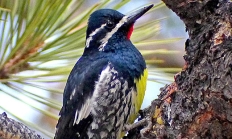
Lines of neatly drilled holes in even the smallest strand of aspen east of the Cascade summit are likely the work of the Red-naped sapsucker. The Red-naped sapsucker is a common summer resident throughout forested mountains east of the crest of the Cascades and a spring and fall migrant through the same mountains and lower elevations, preferring areas with trees. Hear the call of the Red-naped sapsucker Photo by Tom Koerner, USFWS
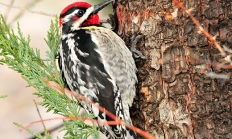
This medium-sized woodpecker may be found in virtually any forested area in Oregon. It is found primarily in mixed-conifer and ponderosa pine forests, as well as adjacent deciduous stands, especially during the breeding season. Hairy woodpeckers feed on beetles, ants and other insects, spiders, miscellaneous plant matter, elderberry corn and mast (mostly acorns), and a few seeds. They are regular visitors to suet feeders and have been observed drinking from hummingbird feeders in central Oregon. It is a resident in forests throughout Oregon with the exception of juniper. Common throughout most of this range, but uncommon to fairly common along
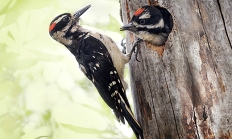
The White-headed woodpecker is the only woodpecker that relies heavily on the seeds of ponderosa pine for food. It occurs mainly in open ponderosa pine or mixed conifer forests dominated by ponderosa pine. They usually excavate nest cavities in snags but may use stumps, leaning logs and dead tops of live trees. It is an uncommon permanent resident in forests of the Ochoco, Blue, and Wallowa mountains and the east side of the Cascades, but suitable habitat is restricted. The White-headed woodpecker is an Oregon Conservation Strategy Species in the Blue Mountains, East Cascades, and Klamath Mountains ecoregions. Hear the

In Oregon, the American three-toed woodpecker tends to use higher-elevation forests; however, forest type may not be as important to this species as the presence of bark beetles. Nests are often fairly low; nest trees are often smaller in diameter than those used by other cavity nesters. Habitat requirements may include trees with heartrot for nesting and high densities of bark or wood-boring beetles. It is rare and local, particularly near and west of the Cascade summit, often near high-elevation lakes or beetle outbreaks. American three-toed woodpeckers are Oregon Conservation Strategy Species in the Blue Mountains and East Cascades ecoregions
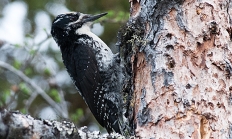
The Black-backed woodpecker can often be found in the open expanses of a recent forest fire or the twiggy closets of a bark beetle outbreak. It may be heard before seen, with its accelerating drum ringing from a prominent snag or its snarling call. Its nest is often low in a tree; both living and dead trees are used, but may require heartrot for excavation of nest cavities. Nest trees are often smaller in diameter than those used by other cavity nesters. It is a rare to locally common resident near the summit and on nearby plateaus and ridges on
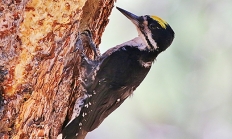
The Northern flicker is larger than most woodpeckers in Oregon. It is primarily lighter shades of brown and gray with black markings: spotted underparts, barred back, and a broad necklace. Its wing linings and undertail range from salmon to yellow, and the rump is white. Males have a red or black mustache. Northern flickers may be encountered in almost any terrestrial habitat, but are generally most abundant in open forests and forest edges adjacent to open country. They venture into nearby habitats, including towns and farms but typically avoid dense forests. It is a common resident throughout Oregon. Hear the
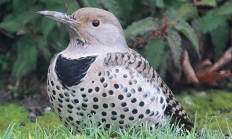
The Pileated woodpecker was the model for the cartoon character, Woody Woodpecker. It is a large black-and-white bird with a bold red feathered crest and distinctive call. You may hear its powerful drumming before you see it. In Oregon, its habitat includes older forests in the Blue Mountains, East and West Cascades, Klamath Mountains, Willamette Valley and Coast Range ecoregions. They prefer mature forests and younger forests with large snags and logs, requiring large diameter snags for nesting and foraging. Pileated woodpeckers are an Oregon Conservation Strategy Species in the Blue Mountains ecoregion. Hear the call and the drumming of
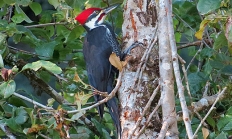
Plumage and structure of flycatchers is so similar that their call is the primary field mark. Oregon has one lark species, the Horned lark that breeds in small scattered populations throughout the Willamette Valley. The Western meadowlark is in a different family and is related to the blackbird, grackle and oriole.
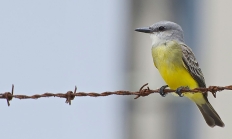
The Olive-sided flycatcher is one of the most recognizable breeding birds of Oregon's conifer forests with its resounding, three-syllable whistle song quick, three beers. It is a relatively large, somewhat bulky, large headed, short-necked flycatcher that perches erect and motionless at the top of a tall tree or snag except when singing or darting out to capture flying insects. The overall olive-gray plumage is generally nondescript except for a whitish stripe down the breast and belly which gives the impression of an unbuttoned vest, and white patches between the wings and lower back. This flycatcher breeds in low densities throughout
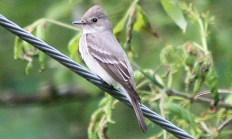
The down-slurred pee-eer call of this flycatcher is one of Oregon's most characteristic summertime bird sounds. Wherever there is a canopy of mature deciduous trees, one is likely to hear the call during warm afternoons when most other birds are silent. Because the call can easily be heard, it can usually be found perched near the tip of a dead branch from which it frequently flies a short distance to capture a flying insect, or to chase an intruder from its territory. The Western wood-pewee is a common migrant and fairly common breeder statewide in open groves of trees or
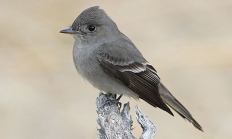
This long-distance, relatively late-arriving migrant to Oregon is associated with shrub-dominated habitats, especially riparian willow thickets. The plumage has subtle tones of olive-green and gray; the species is without a visible eye-ring but the characteristic sneezy, abrupt song reveals its presence. The Willow flycatcher breeds in western Oregon from sea level along the coast and interior to above 5,000 feet west of the Cascades summit. In eastern Oregon it breeds mostly above 1,000 feet from Klamath to Burns and also Lake County and Union County. The habitat of breeding Willow flycatchers is characterized by dense shrubs and/or tall herbaceous plants

Among the least conspicuous of Oregon's birds, this inhabitant of arid country may be found in pine and juniper woodland and sagebrush shrubland. A particularly drab member of the difficult-to-identify flycatchers, the Gray flycatcher can most readily be recognized by its downward tail-bobbing motion. Other identification features include its overall gray coloration, its relatively long bill and tail, and a habit of frequently dropping to the ground from low perches in pursuit of food. It is an uncommon to locally fairly common breeder east of the Cascade summit and rare but annual along the west slope of the Cascades during
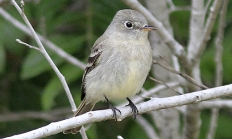
The Dusky flycatcher inhabits open conifers, conifer-hardwoods, or shrubs in the mountains of Oregon. A medium-sized Empidonax with a small head and rounded crown, the upperparts are grayish olive to grayish brown, the throat grayish, and the underparts mostly whitish with an olive-gray wash (sometimes yellowish). The wings have two narrow, usually whitish wingbars. The narrow white eye ring and pale lores give the appearance of spectacles. This flycatcher is a common summer resident in most of its breeding range in Oregon. It is found the entire length of the Cascades, but habitat is limited west of the summit in
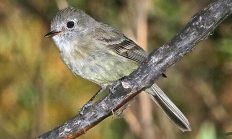
This small greenish flycatcher is easily overlooked in the moist, shady forests where it makes its summer home. It is a common to abundant breeder in forests of the Coast Range and west Cascades below about 4,000 feet and a common transient in western Oregon. The Pacific-slope flycatcher is most easily detected and identified by voice, but there is incongruence between published descriptions of vocalizations and some birds heard in the field lessens the certainty of identification to species, especially those in eastern Oregon. Hear the sounds of the Pacific-slope flycatcher Photo by Trish Gussler, Flickr
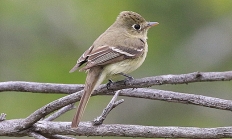
The Cordilleran flycatcher was recently designated a species distinct from the Pacific-slope flycatcher with which it was formerly lumped under the name Western flycatcher. The two species are almost identical in appearance, and the population in eastern Oregon is in some respects vocally intermediate between the Cordilleran and Pacific-slope types, so the distribution and status of the Cordilleran n Oregon is unclear. This species generally occurs in drier, higher elevation forests than the Pacific-slope flycatcher and is more closely associated with riparian zones. Hear the song of the Cordilleran flycatcher Photo by Julio Mulero, Flickr
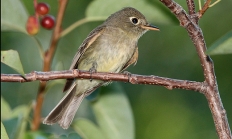
This medium-sized flycatcher has expanded its breeding range from northern California to southwestern Oregon and continues to expand its range in Oregon. First experiences with the species may bring to mind a Slate-colored Junco behaving like a flycatcher. The Black phoebe is dull, sooty black overall, somewhat paler on the back, with a white belly contrasting with the black breast and sides. Bill, legs, and feet are black. The phoebe dips its tail repeatedly. Black phoebes are associated with water. Slow-flowing, idle, or slack water of large rivers, streams, and creeks, ephemeral and permanent ponds, lake shorelines, irrigation ditches, and

